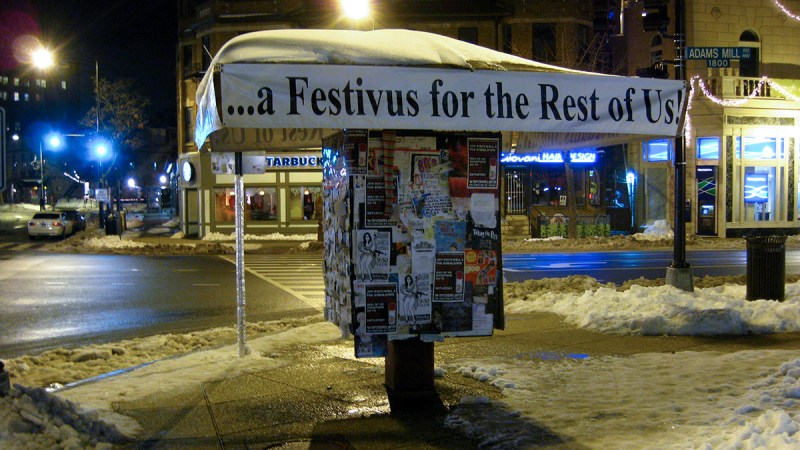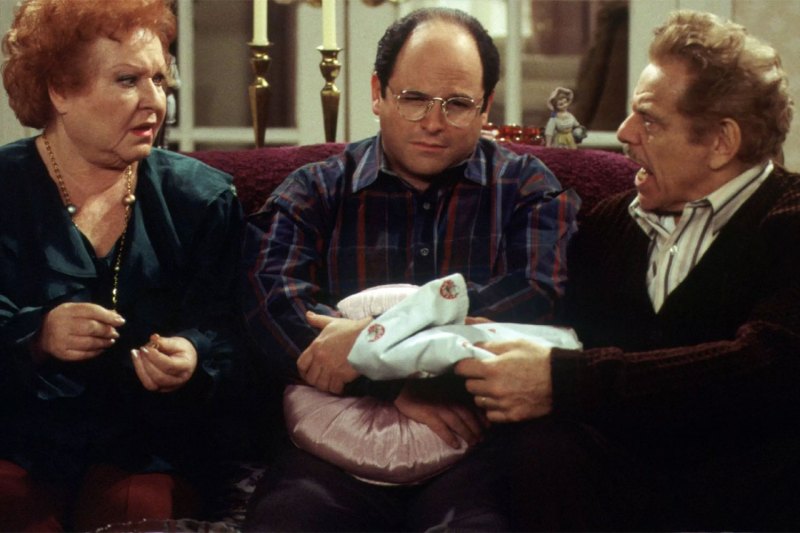
“Dear son, Happy Festivus.” These are the words that introduced us to the holiday known as Festivus on an episode of the classic television show Seinfeld in 1997.
Festivus was created by George Costanza’s father, Frank, as an alternative to Christmas. The holiday falls on December 23 (“To get a leg up on Christmas,” Frank claimed). Its origin story dates back to George’s youth when Frank went to the store to buy a doll for his son. Another father was reaching for the same toy — the last on the shelf — leading Frank to “rain blows upon him … I realized there must be another way.”
In essence, Festivus rejects the commercial and religious aspects of Christmas. The sparkling Christmas tree adorned with lights and ornaments is replaced by a plain aluminum pole. There are no presents. Instead of a large feast, dinner consists of meatloaf on a bed of lettuce. From there, the tradition goes as such:
- Put a clock in a bag and nail it to the wall (which is considered “the true symbol of Festivus”).
- Sit down for dinner.
- Before eating comes the “Airing of Grievances,” an opportunity to tell others how they have disappointed you in the past year.
- Enjoy Festivus dinner.
- Amid dinner, the Feats of Strength begin, where the head of the household must be pinned by other family members. The honor goes to someone at the table.
- Festivus is not over until the head of the household is pinned.

Festivus is cheaper than Christmas
Compared to spending the ever-awkward Christmas Eve with family and going broke buying gifts, Festivus may sound pretty peachy. Especially considering the average U.S. adult was prepared to spend $875 on holiday-related items, according to a November 2023 release from the National Retail Federation.
Festivus, on the other hand, costs as much as a single aluminum pole, meatloaf dinner, a clock, a bag, and a single nail, which may be why the celebration has withstood the test of time and is still celebrated over 20 years, albeit primarily by “stoned college students and federal prisoners around the country,” says Dan O’Keefe, a writer on Seinfeld who drew from personal experience for the episode.
O’Keefe explained to The Washington Post in 2009 that it wasn’t until the age of eight that he learned Festivus was not a “real” holiday celebrated by the other kids at school. O’Keefe says, “I mentioned to a kid on the bus we had Festivus last night … He said “Whaaaaaat?” I soon realized to keep my mouth shut about it, and I did for literally 20 years with outsiders, to the point I had actually repressed/forgotten it, until my younger brother [Mark O’Keefe, who wrote Bruce Almighty and Click] mentioned it to the Seinfeld head writers and they made me stick it in an episode, although I fought against it.” Fellow writer Jeff Schaffer, who launched The League, came up with the aluminum pole.
Changing your annual end-of-the-year celebration to Festivus also means you don’t have to give presents to office co-workers. Instead, you can ask for a simple donation to The Human Fund, a fictitious charity created by George to dodge the expense of gifting.
The holiday’s official slogan — “A Festivus for the rest of us” — is quick to explain that the holiday does not discriminate and is open for all to observe. The degree to which you practice is up to you. O’Keefe, who has also written for Silicon Valley and Veep, even wrote a book on it called The Real Festivus. This definitive guide covers the complete history, customs, games, party themes, and trivia — everything you need to know about the cult phenomenon.
“Today’s modern man can easily embrace the masculine elements of Festivus, of which there are many,” adds Mark Nelson, webmaster of FestivusWeb.com and author of Festivus! The Book: A Complete Guide to the Holiday for the Rest of Us. “First, the charmingly minimalist aluminum pole … then meatloaf, which is largely considered to be the classic meal of the working man, and, finally, the feats of strength; a manly bout of wrestling where the head of the household is pinned to the floor. Festivus might not be your father’s holiday, but the fictitious Frank Costanza was clearly thinking like a man.”

Feast on this Festivus meatloaf recipe
Do you have your aluminum pole? What about your grievances? Do you have them written down so you can air them at the proper time? Have you been in training for the feats of strength? Do you have the meatloaf prepared?
What? You don’t have the meatloaf? Well, we’ve got you covered there. You can have the very same meatloaf that graced the table at the Costanza home thanks to this recipe from Julie Tremaine’s Seinfeld: The Official Cookbook. You’ll have to find a clock, bag, and nail on your own.
Ingredients
Glaze
- 1/2 cup tomato paste
- 1/4 cup brown sugar
- 1/4 cup white vinegar
- 1 teaspoon yellow mustard
Meatloaf
- 1 pound ground beef
- 1 pound ground pork
- 1/4 cup grated onion
- 1 egg
- 1 cup seasoned bread crumbs
- 1/4 cup tomato paste
- 1 tablespoon Worcestershire sauce
- 1 teaspoon salt
- 1/2 teaspoon pepper
- 1 teaspoon Italian seasoning
- 1 teaspoon garlic powder
Method
- Preheat the oven to 350 degrees Fahrenheit.
- Mix all the ingredients for the glaze in a bowl and set aside.
- Spray a loaf pan with cooking spray.
- In a large bowl, combine all the meatloaf ingredients until they are mixed well.
- Put the meatloaf ingredients in the loaf pan and top with the glaze.
- Bake for 75 to 80 minutes, or until the internal temperature reaches 155 degrees Fahrenheit.
- Allow it to cool slightly and slice and serve on a bed of lettuce (for an authentic Festivus dish).
So now our only question is: Who’s hosting this year’s Festivus?



